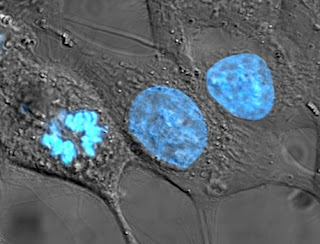My last assignment for BioTechniques web news was a cell culture themed newsletter article on the status of cell line contamination. It was while researching that article (Ending cell line contamination by cutting off researchers) that I got my first real education about HeLa cells. I recently added to that education by reading Rebecca Skloot’s The Immortal Life of Henrietta Lacks for J669.
I already had a firm grasp on the science of cell culture and contamination of cell lines, but the book gave me a lot of background about Henrietta Lacks, the woman the HeLa cell line was harvested from (and thus named after). Cell line contamination is the dirty little secret of the biological research community, and the story of the Lacks family certainly doesn’t make the research community look any better.
 |
| HeLa Cells. Source: Wikimedia Commons. |
One thing that I like about Skloot’s book is that she doesn’t look at either the family or the researchers involved in the HeLa controversy with rose colored glasses. I think the book is fair because it drives home the point that the researchers involved in cell culture in the 1950’s all followed protocol at the time. There isn’t a single person to blame for the fact that Henrietta Lacks’ cells were cultured without her consent or that no one ever bothered to educate her family about cells, what it means to grow them in culture, and the research that cell culture enables.
It wasn’t standard practice back then to tell research subjects much of anything. Not that I think what happened to the Lacks family is ok, I believe in informed consent – even if that means giving someone the basic science education they need to understand what will happen to their tissues once they give them up to science. But, hopefully publicizing more stories like the Lacks family’s will help people speak up and learn more about biological research.
I found Skloot’s book compelling, but my biggest problem with it was the ending. To me, it just ends abruptly. The death of Lack’s daughter Deborah (who is a major character in the book through her interactions with Skloot) gives the book an ending of sorts, but something is still missing. I wish that there was something that could tie the book together like a change in policy or new regulations put in place, but sadly no such changes have occurred.
Cell line contamination is a rampant problem in the biological research community, and currently in the United States there are no regulations that force researchers to verify the origin of their cells lines or identify the contaminants they may have been exposed to. Cell line contamination pisses me off. We spend billions of tax dollars on research — that may end up completely worthless because researchers have no incentive to check and make sure that the cells they are working with are what they think they are. What good is research for treatments for blindness when you aren’t working with corneal cells, you are actually working with cervical cancer cells?
If you want to learn more about cell line contamination, a search in PubMed (a database of academic research papers) for Roland Nardone will yield several academic papers on the issue, but I suggest reading “Recommendation of short tandem repeat profiling for authenticating human cell lines, stem cells, and tissues,” because it actually offers a solution to the problem of how to authenticate cells.